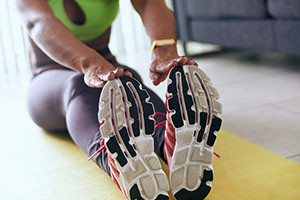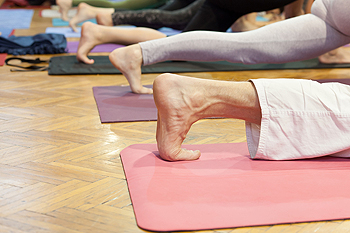Items filtered by date: February 2021
What Are Common Running Injuries?
 The benefits of incorporating running into a frequent routine can include burning excess calories and toning the body. Despite the benefits people may experience from running, there are a variety of foot injuries that can occur. These can include black toenails, which can happen from the nail consistently hitting the top of the shoe. This can cause bleeding underneath the toenail, and the nail may gradually fall off. Additionally, plantar fasciitis can result from wearing shoes that do not fit correctly, or from running on uneven surfaces. Patients may develop blisters and heel spurs, which can make it painful to run. If you would like more information about how to prevent running injuries, it is recommended that you confer with a podiatrist who can address any concerns that you may have.
The benefits of incorporating running into a frequent routine can include burning excess calories and toning the body. Despite the benefits people may experience from running, there are a variety of foot injuries that can occur. These can include black toenails, which can happen from the nail consistently hitting the top of the shoe. This can cause bleeding underneath the toenail, and the nail may gradually fall off. Additionally, plantar fasciitis can result from wearing shoes that do not fit correctly, or from running on uneven surfaces. Patients may develop blisters and heel spurs, which can make it painful to run. If you would like more information about how to prevent running injuries, it is recommended that you confer with a podiatrist who can address any concerns that you may have.
Exercising your feet regularly with the proper foot wear is a great way to prevent injuries. If you have any concerns about your feet, contact Dr. Steven Sheridan of Ankle & Foot Specialty Clinics. Our doctor will treat your foot and ankle needs.
How to Prevent Running Injuries
Many common running injuries are caused by overuse and overtraining. When the back of the kneecap starts wearing out and starts causing pain in your knee, this is commonly referred to as runner’s knee. Runner’s knee is a decrease in strength in your quadriceps and can occur if you’re not wearing properly fitted or supporting shoes. To prevent runner’s knee, focusing on hip strengthening is a good idea, as well as strengthening your quads to keep the kneecaps aligned.
What Are Some Causes of Running Injuries?
- One cause of a common running injury is called iliotibial band syndrome.
- Plantar fasciitis is also another common injury.
- Stress fractures can occur from overtraining, lack of calcium, or even your running style.
Best Ways to Prevent Running Injuries
- Wear footwear that fits properly and suits your running needs.
- Running shoes are the only protective gear that runners have to safeguard them from injury.
- Make a training schedule. Adding strengthening exercises as well as regular stretching can help keep you strong and limber and can lessen the possibility of injuries.
- Stretching keeps muscles limber; this will help you gain better flexibility.
If you have any questions please feel free to contact our office located in Sandusky, MI . We offer the newest diagnostic and treatment technologies for all your foot and ankle needs.
Plantar Fasciitis Stretching Tips
 The plantar fascia is a portion of tissue that is found on the sole of the foot. Its function is to connect the heel to the toes, and it is instrumental in walking and completing daily activities. Plantar fasciitis occurs when this band of tissue becomes inflamed, causing difficulty walking, running, and doing other activities. There are simple stretches and exercises that may help to relieve part of the pain that often accompanies plantar fasciitis. Many patients find it helpful to stand on a step, and gently lower one heel at a time until a stretch is felt. Additionally, it is beneficial to push against a wall while keeping the back leg straight, as this can help stretch the Achilles tendon which is connected to the heel. Please consult with a podiatrist if you would like more information about how to perform efficient stretches for plantar fasciitis.
The plantar fascia is a portion of tissue that is found on the sole of the foot. Its function is to connect the heel to the toes, and it is instrumental in walking and completing daily activities. Plantar fasciitis occurs when this band of tissue becomes inflamed, causing difficulty walking, running, and doing other activities. There are simple stretches and exercises that may help to relieve part of the pain that often accompanies plantar fasciitis. Many patients find it helpful to stand on a step, and gently lower one heel at a time until a stretch is felt. Additionally, it is beneficial to push against a wall while keeping the back leg straight, as this can help stretch the Achilles tendon which is connected to the heel. Please consult with a podiatrist if you would like more information about how to perform efficient stretches for plantar fasciitis.
Stretching the feet is a great way to prevent injuries. If you have any concerns with your feet consult with Dr. Steven Sheridan from Ankle & Foot Specialty Clinics. Our doctor will assess your condition and provide you with quality foot and ankle treatment.
Stretching the Feet
Stretching the muscles in the foot is an important part in any physical activity. Feet that are tight can lead to less flexibility and make you more prone to injury. One of the most common forms of foot pain, plantar fasciitis, can be stretched out to help ease the pain. Stretching can not only ease pain from plantar fasciitis but also prevent it as well. However, it is important to see a podiatrist first if stretching is right for you. Podiatrists can also recommend other ways to stretch your feet. Once you know whether stretching is right for you, here are some excellent stretches you can do.
- Using a foam roller or any cylindrical object (a water bottle or soda can will do), roll the object under your foot back and forth. You should also exert pressure on the object. Be sure to do this to both feet for a minute. Do this exercise three times each.
- Similar to the previous one, take a ball, such as a tennis ball, and roll it under your foot while seated and exert pressure on it.
- Grab a resistance band or towel and take a seat. If you are using a towel, fold it length wise. Next put either one between the ball of your foot and heel and pull with both hands on each side towards you. Hold this for 15 seconds and then switch feet. Do this three times for each foot.
- Finally hold your big toe while crossing one leg over the other. Pull the toe towards you and hold for 15 seconds. Once again do this three times per foot.
It is best to go easy when first stretching your foot and work your way up. If your foot starts hurting, stop exercising and ice and rest the foot. It is advised to then see a podiatrist for help.
If you have any questions, please feel free to contact our office located in Sandusky, MI . We offer the newest diagnostic and treatment technologies for all your foot care needs.
Sever’s Disease May Cause Heel Pain in Children
 Sever’s disease occurs when the bones in the calves grow faster than the Achilles tendon, which connects the heel bone to the calf muscle. When this happens, the tendon begins to tighten, and the heel becomes swollen and sore. Sever’s disease often affects children between the ages of 9 and 13 who are participants in running and jumping sports such as soccer, gymnastics, baseball, basketball, and football. There is rarely swelling as a result, and most often, the heel pain is worse when running with shoes that have limited support. The pain usually goes away with rest and does not have an impact with low impact sports such as cycling and swimming. If your child complains of heel pain, you should take them to see a podiatrist for a proper examination. Upon examination, a podiatrist will be able to provide a proper diagnosis and treatment method.
Sever’s disease occurs when the bones in the calves grow faster than the Achilles tendon, which connects the heel bone to the calf muscle. When this happens, the tendon begins to tighten, and the heel becomes swollen and sore. Sever’s disease often affects children between the ages of 9 and 13 who are participants in running and jumping sports such as soccer, gymnastics, baseball, basketball, and football. There is rarely swelling as a result, and most often, the heel pain is worse when running with shoes that have limited support. The pain usually goes away with rest and does not have an impact with low impact sports such as cycling and swimming. If your child complains of heel pain, you should take them to see a podiatrist for a proper examination. Upon examination, a podiatrist will be able to provide a proper diagnosis and treatment method.
Sever's disease often occurs in children and teens. If your child is experiencing foot or ankle pain, see Dr. Steven Sheridan from Ankle & Foot Specialty Clinics. Our doctor can treat your child’s foot and ankle needs.
Sever’s Disease
Sever’s disease is also known as calcaneal apophysitis, which is a medical condition that causes heel pain I none or both feet. The disease is known to affect children between the ages of 8 and 14.
Sever’s disease occurs when part of the child’s heel known as the growth plate (calcaneal epiphysis) is attached to the Achilles tendon. This area can suffer injury when the muscles and tendons of the growing foot do not keep pace with bone growth. Therefore, the constant pain which one experiences at the back of the heel will make the child unable to put any weight on the heel. The child is then forced to walk on their toes.
Symptoms
Acute pain – Pain associated with Sever’s disease is usually felt in the heel when the child engages in physical activity such as walking, jumping and or running.
Highly active – Children who are very active are among the most susceptible in experiencing Sever’s disease, because of the stress and tension placed on their feet.
If you have any questions, please feel free to contact our office located in Sandusky, MI . We offer the newest diagnostic and treatment technologies for all your foot and ankle injuries.
Consequences of Fallen Arches
 Fallen arches or acquired flat feet occur when the arches of the feet collapse over time due to a weakening of the tendon that supports the arch. One of the main functions of the arches is to flex and absorb shock. When the arches are flat, stress is transferred up into the legs, hips, and lower back, causing pain in both the feet and these areas higher up in the body. Fallen arches can also cause the ankle and leg bones to rotate slightly, which can make ankle and ACL injuries more likely. If you have fallen arches, it is recommended that you seek the care of a podiatrist, who can help prevent or minimize the pain and discomfort caused by this condition.
Fallen arches or acquired flat feet occur when the arches of the feet collapse over time due to a weakening of the tendon that supports the arch. One of the main functions of the arches is to flex and absorb shock. When the arches are flat, stress is transferred up into the legs, hips, and lower back, causing pain in both the feet and these areas higher up in the body. Fallen arches can also cause the ankle and leg bones to rotate slightly, which can make ankle and ACL injuries more likely. If you have fallen arches, it is recommended that you seek the care of a podiatrist, who can help prevent or minimize the pain and discomfort caused by this condition.
Flatfoot is a condition many people suffer from. If you have flat feet, contact Dr. Steven Sheridan from Ankle & Foot Specialty Clinics. Our doctor will treat your foot and ankle needs.
What Are Flat Feet?
Flatfoot is a condition in which the arch of the foot is depressed and the sole of the foot is almost completely in contact with the ground. About 20-30% of the population generally has flat feet because their arches never formed during growth.
Conditions & Problems:
Having flat feet makes it difficult to run or walk because of the stress placed on the ankles.
Alignment – The general alignment of your legs can be disrupted, because the ankles move inward which can cause major discomfort.
Knees – If you have complications with your knees, flat feet can be a contributor to arthritis in that area.
Symptoms
- Pain around the heel or arch area
- Trouble standing on the tip toe
- Swelling around the inside of the ankle
- Flat look to one or both feet
- Having your shoes feel uneven when worn
Treatment
If you are experiencing pain and stress on the foot you may weaken the posterior tibial tendon, which runs around the inside of the ankle.
If you have any questions please feel free to contact our office located in Sandusky, MI . We offer the newest diagnostic and treatment technologies for all your foot and ankle needs.
